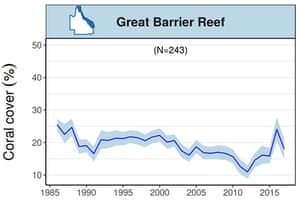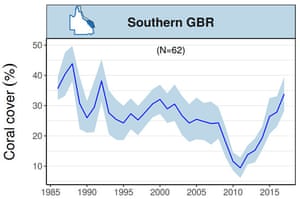
Coral reefs are sprawling, intricate ecosystems that house an estimated 25 percent of all marine life and can sometimes be seen from space. Yet they are formed by a process invisible to us.
A study published in Science
on Wednesday now presents a microscopic picture of the biology that
makes corals’ skeletons grow. The findings suggest that coral may be
more robust in the face of human-driven ocean acidification than commonly thought.
Corals
grow their armor by diligently secreting a chunk of hard skeleton
smaller than the width of a human hair each day. This process is called
calcification and scientists have debated which parts of it are most
important for decades.
One view prioritizes chemical interactions with the seawater. Using ion pumps,
corals can possibly decrease the acidity of seawater enough that
calcium carbonate — the stuff of limestone and chalk and the basis of
coral skeletons — forms spontaneously. Under these circumstances, if
oceans become more acidic — a potential consequence of human-emitted carbon dioxide in the atmosphere being absorbed by the seas — coral may struggle to form a skeleton.
The
alternative view contends that calcification is primarily a biological
process, coordinated by proteins similar to the ones that help us make
our teeth and bones. The new study provides evidence for this
perspective and some hope for corals in a world with more carbon.
“Coral is not just a rock,” said Paul Falkowski,
a professor of marine sciences at Rutgers University and senior author
of the study. “And because of that, we’re pretty confident that they’ll
be able to continuing making their skeletons even if the ocean becomes
slightly more acidic.”
Not all scientists agree.
“The problem is, we have lots of data that show many coral species are very sensitive to environmental change,” said Alexander Venn,
a senior scientist at the Scientific Center of Monaco, who was not
involved in the study. “While this paper builds a strong model for the
biological control of calcification, there are still pieces of the
puzzle missing.”
Dr. Falkowski and his colleagues used ultrahigh-resolution microscopic imaging and techniques for observing the structure of molecules to study skeletal branches from smooth cauliflower coral, a well-studied species common in the Indo-Pacific.
The
result is a model of coral calcification that starts with a malleable
form of calcium carbonate, called amorphous calcium carbonate.
The
researchers say they believe that amorphous calcium carbonate is
initially formed by proteins. Through a process not yet fully
understood, little balls of the material then give way to aragonite, the
form of calcium carbonate that makes up a mature coral skeleton.
Similar transitions have been observed in sea urchins and shellfish, and some scientists even suspect amorphous calcium carbonate may be a common precursor for calcification across the tree of life.

“When
we precipitate aragonite in the lab, just in a bucket of seawater, it
forms this very characteristic pattern with very long, needle-shaped
crystals,” said Nicola Allison, a lecturer in earth sciences at the University of St. Andrews, who did not participate in the research.
“This
is the first report of amorphous calcium carbonate in coral, and it
really does suggest the organism is able to control how solid material
is deposited,” she added.
Alex Gagnon,
an assistant professor of oceanography at the University of Washington
who was not involved in the research, suggested it was an
oversimplification to take seawater chemistry out of the equation. Acid
dissolves calcium carbonate, so the more acidic the ocean is, the more
difficult it is for corals to organize that first bit of skeleton.
“At the end of the day, the fundamental rules of chemistry and physics still apply,” he said.
It’s
true that corals lose calcium carbonate in a more acidic environment —
but they maintain the ability to grow back that skeleton, “which is good
news,” Dr. Falkowski said.
Given current projections
of ocean warming and acidification, he is more concerned about warming,
which stresses the algae living inside corals and causes coral bleaching.
That
said, Dr. Falkowski acknowledges that the cause of warming and
acidification is one and the same: carbon emissions from fossil fuel
burning. “For all intents and purposes, they’re linked,” he said.
Sumber : nytimes


